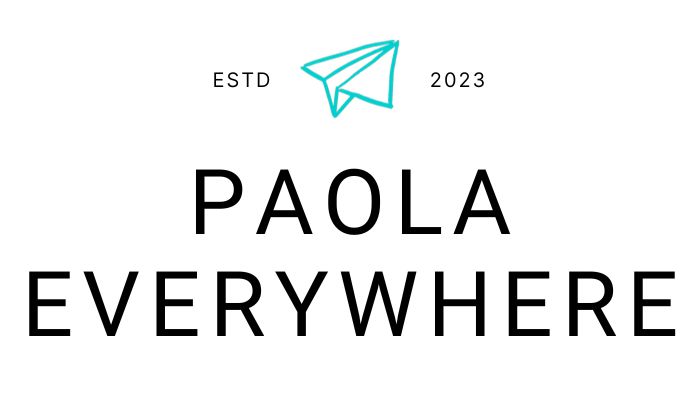Our visit to the Park of Military History Pivka was one of the highlights of our trip to Slovenia. We went there to see tanks and aircraft, but ended up experiencing so much more: from the secrets of the Enigma cypher machine to the story of Yugoslavia’s dissolution. My son and I were especially fascinated by the submarine, once ready to strike Italy during the Cold War. Keep reading to uncover all the secrets of this unique museum.
Table of Contents
Why Visit the Park of Military History Pivka
The Park of Military History Pivka is one of those places worth going out of your way to visit in Slovenia. It’s not located right next to the country’s most famous attractions, such as Postojna Cave or the capital, Ljubljana, but it holds a unique heritage that deserves to be discovered. As the largest museum in Slovenia, it takes you on a real journey through time, with tanks, armoured vehicles, aircraft, and even a submarine.
PLAN YOUR TRIP TO SLOVENIA
Stay connected at all times with a Holafly eSIM with unlimited data: perfect for using maps, always knowing where you are, and sharing your experiences in real time.
Travel worry-free with Heymondo travel insurance, offering full coverage for unexpected events and medical assistance anywhere so that you can enjoy Slovenia with peace of mind.
What makes this museum truly special is that it tells a recent history, one that directly shaped our lives. For those of us who grew up in Europe in the 1980s and 1990s, Yugoslavia is not a distant chapter in history books but a vivid memory of border tensions, geopolitical changes, and the birth of new republics right next door.
For my son, it was fascinating to learn how a once-united country could split into several independent states. What impressed him the most, though, was seeing so many tanks, military trucks, and armoured vehicles up close. It felt like a paradise for anyone who loves these machines, even though we are pacifists at heart. For me, it was equally striking to observe pieces of history usually seen only in films or documentaries and to experience them as part of a cultural and historical narrative.
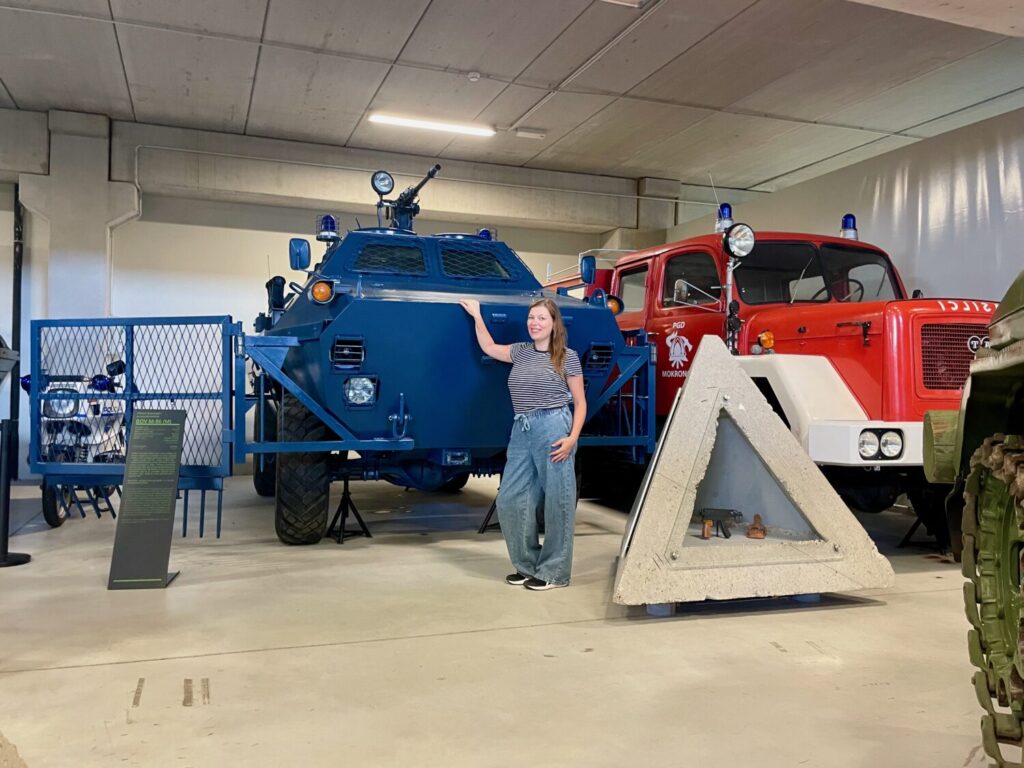
The History of Slovenia: From Yugoslavia to Independence
To fully understand the significance of the Park of Military History Pivka, you need to take a step back and look at Slovenia’s recent history. Until 1991, the country was part of the Socialist Federal Republic of Yugoslavia, a state formed after World War II and led for decades by Marshal Tito.
Yugoslavia was a federal state that united diverse peoples, including Slovenes, Croats, Serbs, Bosnian Muslims, Montenegrins, Macedonians, and Albanians. It was a fragile coexistence of languages, cultures, and religions, such as Catholic, Orthodox, and Muslim, which over time made the federation increasingly unstable.
The Yugoslav People’s Army, well-organised and equipped with powerful military assets, had the mission of keeping the federation united and defending its borders. After Tito’s death, however, the push for independence grew stronger.
In Slovenia, this culminated in the Ten-Day War of June 1991, a brief but intense conflict that marked the birth of the Slovenian Armed Forces and the country’s final break from Yugoslav control.
The museum presents these events with an accessible and educational approach, enriched by original artefacts and detailed panels. Inside the halls, you can follow the story of the Yugoslav army and its transformation after Slovenia’s independence. At the same time, outside the park, you discover how Pivka itself went through important changes.
This small town, in fact, remained under Italian administration until 1943 and was home to a large military base with several barracks. Today, those same buildings have been repurposed as exhibition spaces, transforming a border zone once marked by tensions into a cultural and historical centre of memory.
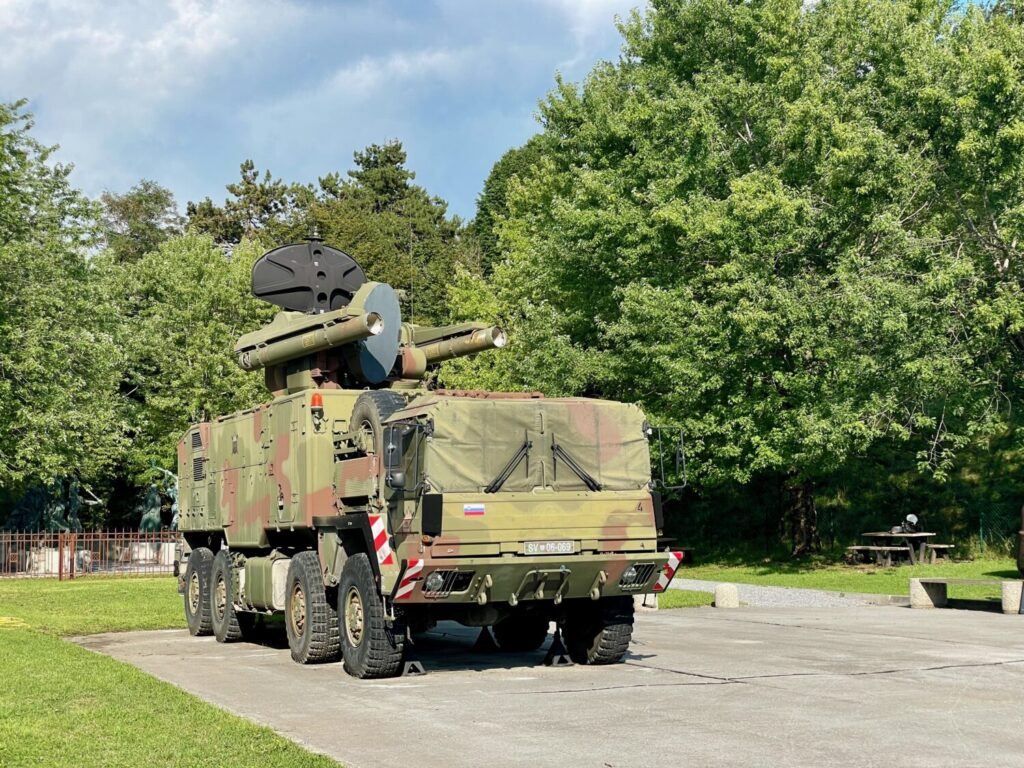
Park of Military History Pivka: From Military Base to Museum
The Park of Military History Pivka stands in a place that has held strategic importance for centuries. The Pivka Valley, connected to the Reka River valley, has always been a crucial area for transport and military control. Its importance grew in 1857 with the construction of the Vienna–Trieste railway, followed in 1873 by the Šempeter–Rijeka line, making the region even more strategic.
After the First World War and the collapse of the Austro-Hungarian Empire, the area came under the control of the Kingdom of Italy, which in the 1930s began to fortify its borders with Yugoslavia. It was during this time that the large Hrastje barracks were built, near San Pietro del Carso (today’s Pivka), known as the Prince of Piedmont Barracks.
The site became the headquarters of the Italian border guard, with its command centre in Trieste. In 1941, it even hosted the first specialised military museum of the region, established by Diego de Henriquez.
In the following decades, the Yugoslav army used the barracks for training and exercises, including operations with special forces and helicopters. After Slovenia’s independence, however, the buildings were gradually abandoned and left to decay.
What struck us most was seeing how this site was not left to oblivion. Instead of erasing the past, the local community chose to restore the barracks after decades of neglect, transforming them into a museum that shares history with new generations.
The park’s mission is not just to display tanks, planes, or submarines, but to provide a place to reflect on the meaning of war and on the transformations that shaped this border region.
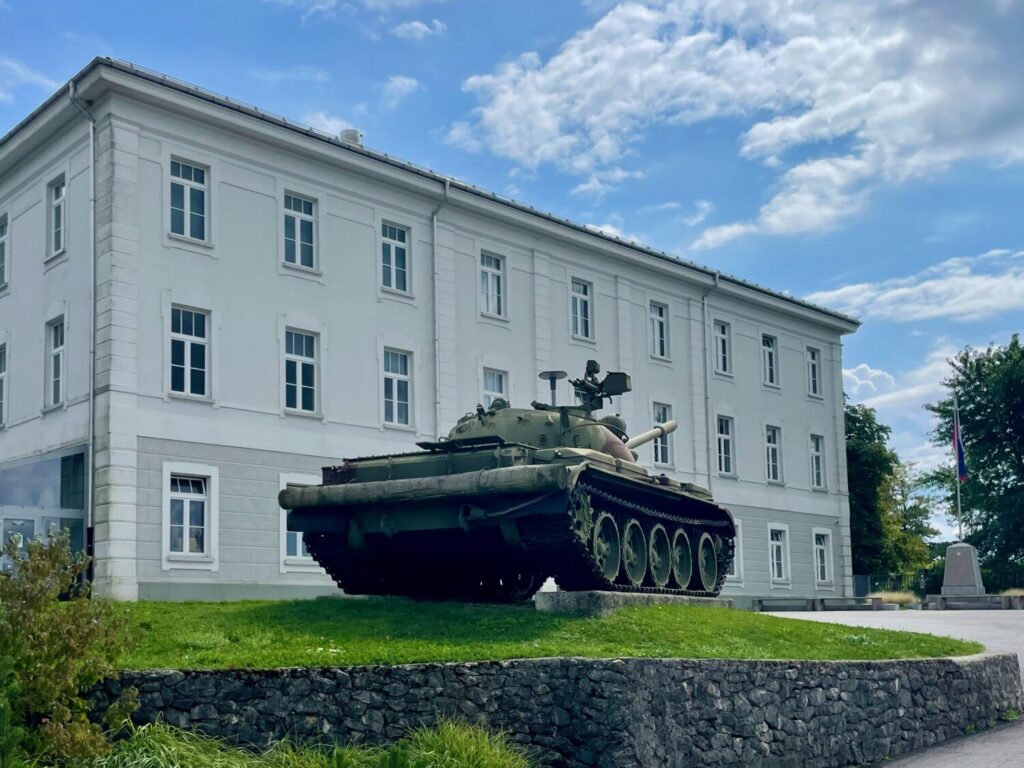
What to See at the Park of Military History Pivka
Your visit to the Park of Military History Pivka begins in the former command building of the base, known as Komanda. Inside, you’ll find a multimedia hall, the first permanent collections, a small café, and a well-stocked souvenir shop with military-themed gifts.
From here, the experience expands into other former military buildings, now transformed into exhibition spaces. Each hall showcases something different: tanks and armoured vehicles from World War II, aircraft, and artillery pieces that trace the evolution of military technology.
The complex, however, is not only about machines of war. Each section brings to life historical events that shaped Slovenia and Europe, such as the country’s independence in 1991. Panels and reconstructions guide visitors through key moments and figures, making history accessible even for younger audiences.
One of the most fascinating exhibitions is the Enigma room, the only space in Europe entirely dedicated to wartime cryptography. This highlight alone makes the trip worthwhile. Here you can explore the secrets of the code that helped change the course of the war and even try your hand at decoding messages. Children can experiment with a simplified version of Enigma or play with Morse code, turning a complex subject into an interactive experience.
The route continues outdoors, where you can see a steam locomotive, a police patrol boat, a submarine, and dozens of heavy vehicles displayed in large hangars. History, technology, and human stories intertwine in a museum that captivates both adults and children.
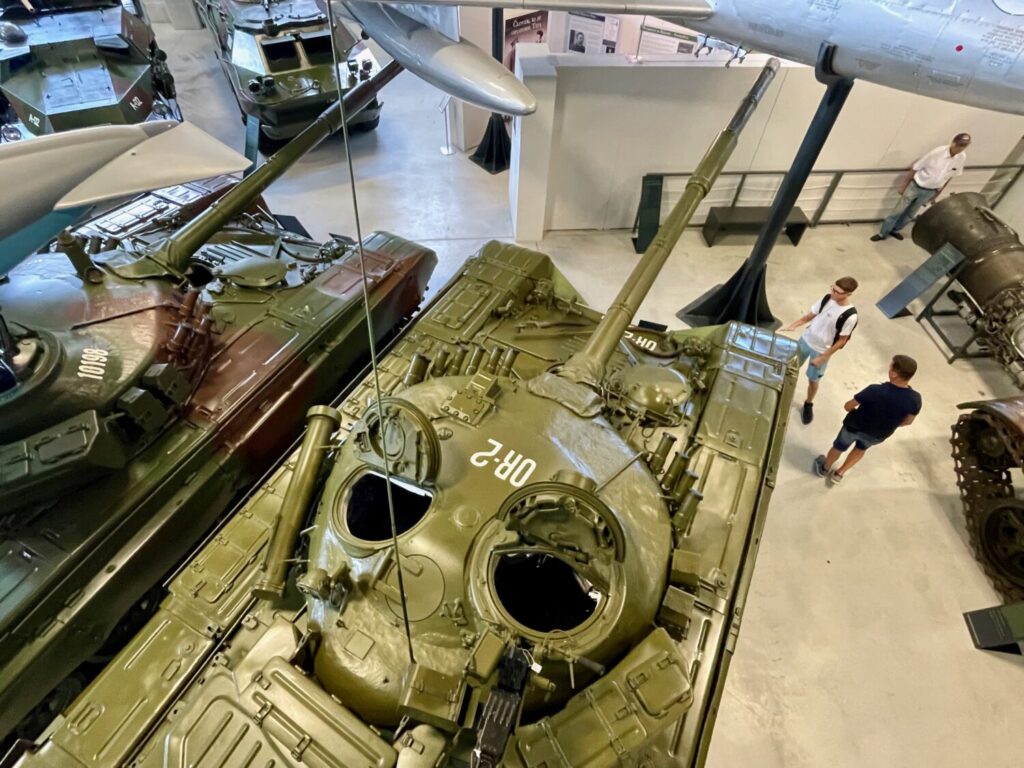
Enigma: the secret code that changed the war
One of the most fascinating sections of the Park of Military History Pivka is about Enigma, the cypher machine used by the Germans to encode their messages during the Second World War. At first glance, it looks like a typewriter, but inside it concealed a clever system of rotors that made the messages almost impossible to break.
At the museum, you can see a genuine Enigma M4, recovered from the wreck of the minesweeper R 15 sunk in the Adriatic in 1945. It is a rare piece: most Enigma machines were deliberately destroyed by German soldiers to avoid falling into enemy hands, but this one still bears the marks of the torpedo that sank the ship.
The exhibition takes you into a world of codes and secrets, enriched with surprising details: the Germans were convinced of Enigma’s invulnerability, while at Bletchley Park, under the guidance of Alan Turing, its messages were already being deciphered almost in real time. The US Army relied on the Navajo language to transmit orders, and Polish cryptographers were among the first to expose Enigma’s weaknesses.
This section was one of our favourites because it explains cryptography in a way that even children can enjoy, starting from Morse code and moving on to increasingly complex systems. For me, it was the most exciting part of the visit: I could have stayed there for hours, fascinated by the idea that behind battles there was a hidden world of codes, secrets and human ingenuity capable of changing the course of history.
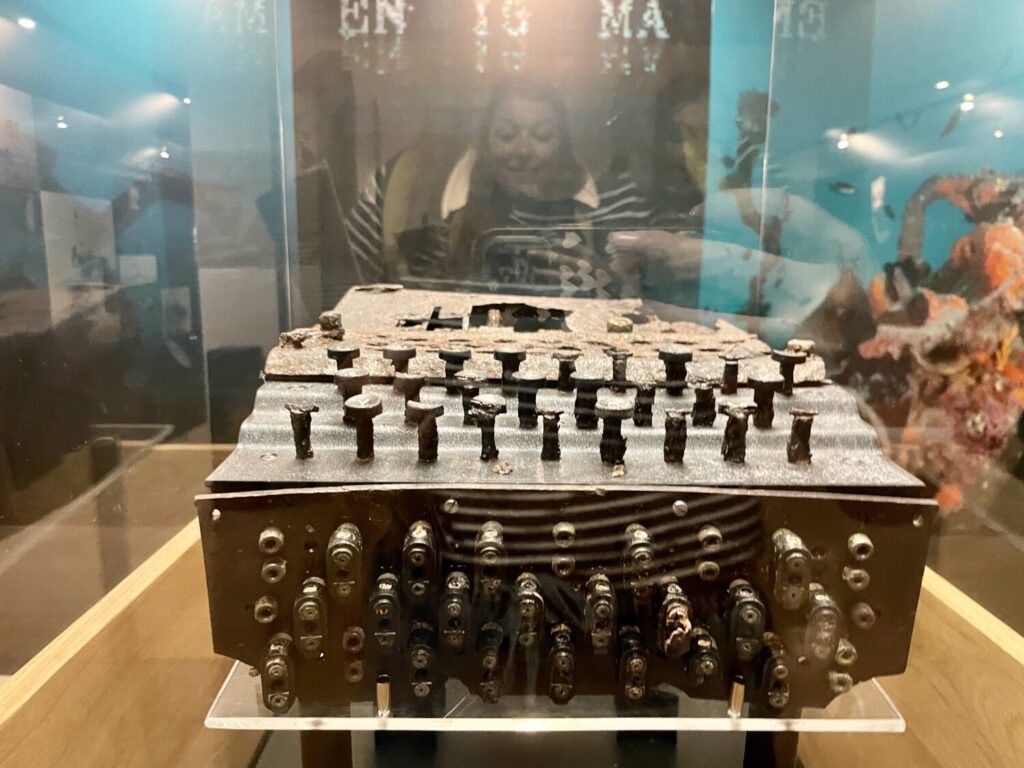
The exhibition on Slovenia’s independence
The central section of the Park of Military History Pivka is about how Slovenia became an independent state. For my son, it was a brand-new discovery, while for me, it felt like a step back into my school years, when this part of history first entered the curriculum and changed the way we studied Europe.
The exhibition explains how Slovenia was once part of the Yugoslav federation, with a single army that had a profound influence on every aspect of daily life. We learned that defence played a role in many areas: children took part in military preparation days at primary school, universities included compulsory protection courses, and even new buildings had to incorporate bunkers.
Alongside the federal army, Slovenians created the Territorial Defence force in 1968, organised locally. Despite attempts by the Yugoslav military to reduce its autonomy, it survived and played a crucial role in 1991, during Slovenia’s fight for independence.
One of the most striking displays shows the Željava underground air base, built beneath Mount Plješevica on the border between Croatia and Bosnia. A large model reconstructs more than 3,500 metres of tunnels, complete with operations centres and fuel depots.
The base could house up to 58 MiG-21 aircraft, hidden behind 1,000-tonne blast doors and a radar station concealed within the mountain. Sadly, during the breakup of Yugoslavia in 1991, the army blew it up. We were disappointed to learn this, as we were ready to adjust our itinerary to visit it in person.
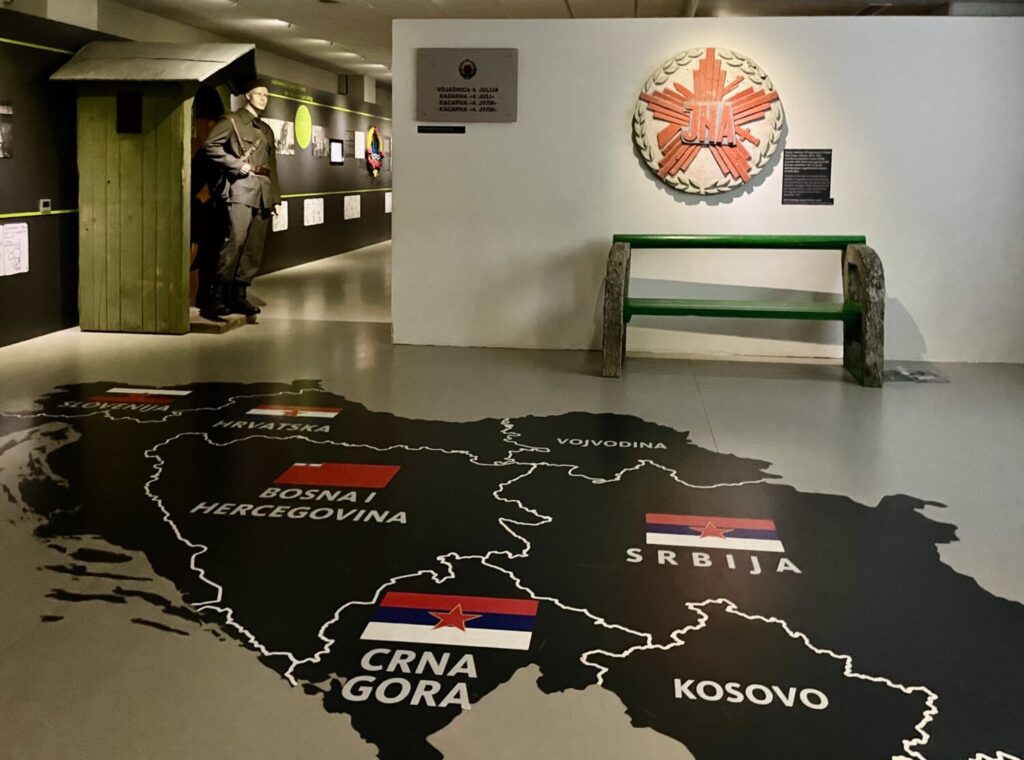
Tanks, artillery and aircraft
Even though we are convinced pacifists, we cannot deny the fascination of the massive military machines displayed at the Park of Military History Pivka. They are potent symbols of an era when military strength was often a matter of survival.
The collection of armoured vehicles is truly impressive: from the American M3 Stuart and Sherman tanks to the Soviet T-34/85 and T-72, all the way to the Yugoslav M-84, considered a significant success of the local arms industry. Seeing them up close makes you realise their enormous size, especially when you come across the striking installation of a red Yugo crushed beneath the tracks of a tank.
There are also rare pieces such as the M36 Jackson self-propelled gun and the German Flak 88, one of the most feared artillery weapons of the Second World War. We were fascinated by the variety on display: from the M5 half-track used for towing guns, to amphibious vehicles, police trucks and civil defence vehicles, each showing the evolution of warfare and national security.
The aircraft section is equally captivating: alongside the American F-84 Thunderjet and F-86 Sabre fighters, supplied to Yugoslavia in the 1950s as military aid, stands the iconic Soviet MiG-21, a symbol of the Cold War and a protagonist across the entire Soviet sphere of influence.
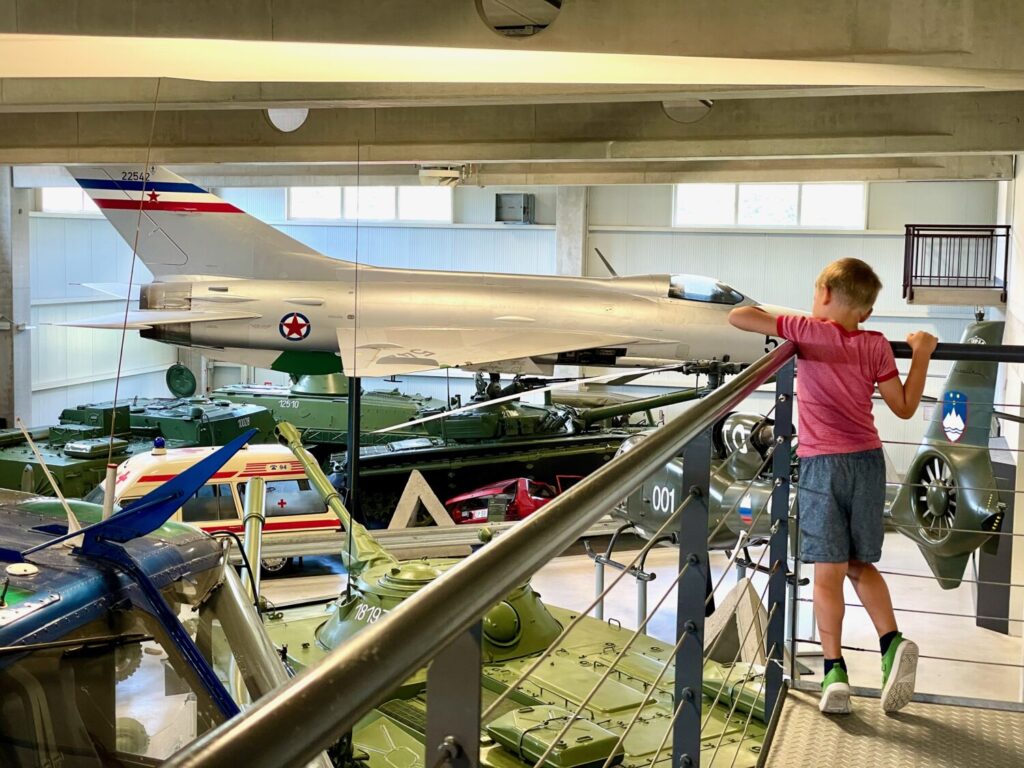
The P-913 Zeta submarine and the life of Yugoslav submariners
Among the most surprising attractions at the Park of Military History Pivka is the P-913 Zeta submarine, just 19 metres long but capable of diving to a depth of 105 metres. It belonged to the Una class, built in Split in the 1980s for special missions in the Adriatic Sea.
On board, there was space for a crew of four plus up to six combat divers, along with naval mines and underwater scooters used to move stealthily beneath the sea. The submarine was not armed with torpedoes but designed to carry commandos and carry out sabotage missions against Italy.
For this reason, the divers were trained to speak Italian so they could move independently if they could not return to the submarine. My son and I were shocked that our holiday destination was once planning to attack our home country!
Visiting the submarine, which is possible only by prior booking, is a truly unique experience. Our guide Blaž explained how harsh life on board was: tiny spaces, constant heat of 25 degrees from the batteries, and no proper toilet, only a chemical one for emergencies. Submariners were trained to minimise their physical needs, and everyone had to learn all tasks in order to replace one another if necessary.
The exhibition around the submarine reveals other aspects of daily life: canned food rations, exhausting shifts, and minimal hygiene to save water. At the same time, such forced proximity created deep bonds and lasting friendships among the crew.
For us, it was a truly special experience: my son and I immersed ourselves in a world of Cold War secrets and stories we had never encountered so closely before.
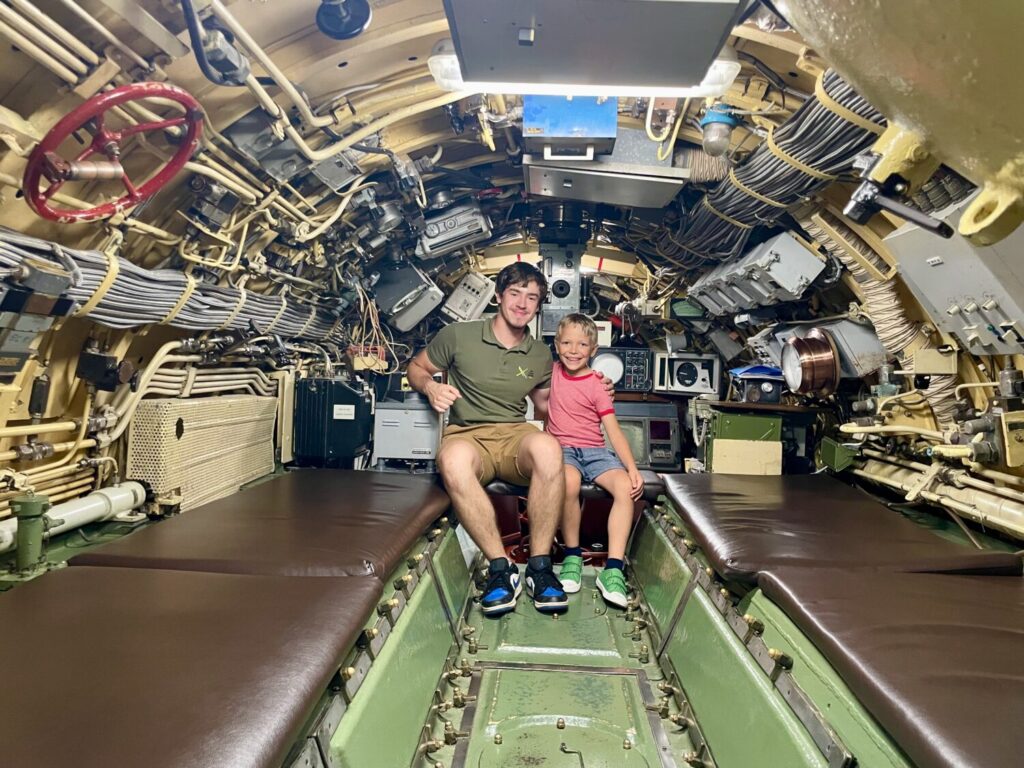
The P-111 police patrol boat: Yugoslavia’s naval strength
At the Park of Military History Pivka, you can also find the P-111 patrol boat, a vessel that for years sailed the Adriatic in service with the Slovenian Maritime Police. With a crew of just four, the Police used it to control borders, monitor maritime routes, enforce fishing laws, and carry out sea rescues.
This boat, built in Viareggio, only reached Slovenia in 1995 after several delays caused by financial difficulties. On board there was also an auxiliary dinghy, essential for moving in shallower waters.
A tour of the P-111’s interior is available by prior booking only. On the day of our visit, we only managed to explore the submarine. Still, we promised ourselves to return one day to step aboard this patrol boat as well.
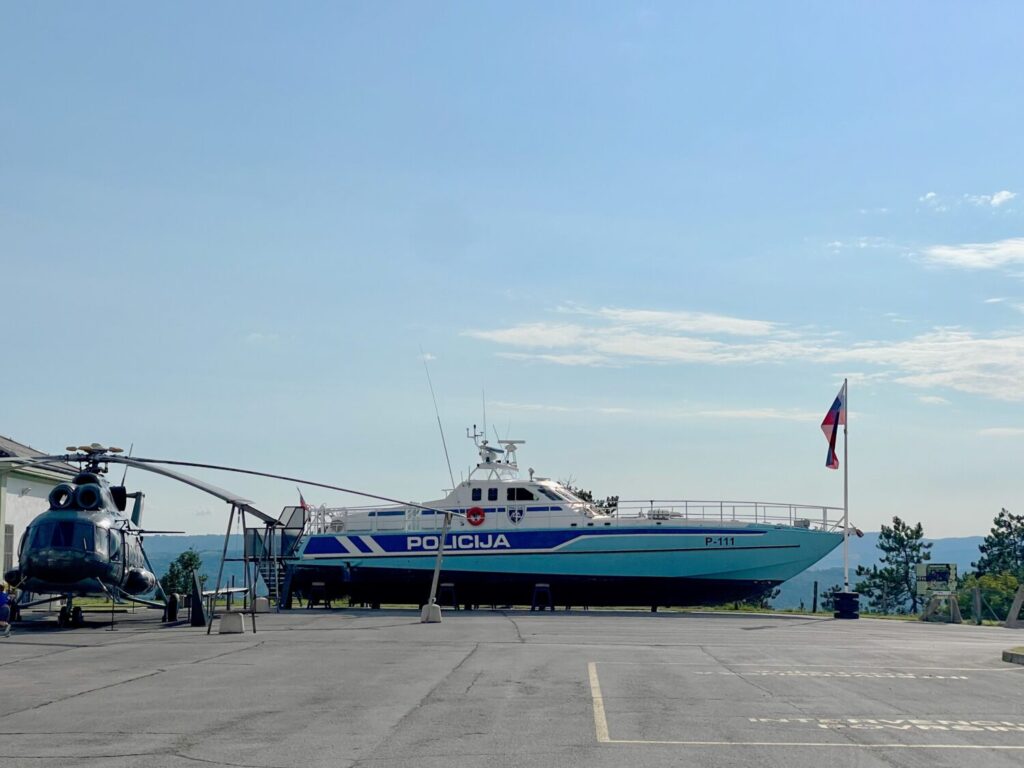
The 33-110 military steam locomotive from the Second World War
Among the most impressive exhibits at the Park of Military History Pivka is the German steam locomotive 33-110, the museum’s largest and heaviest artefact: 95 tonnes of steel and 23 metres in length. Built during the Second World War for military purposes, it completely changed its role after the conflict.
Brought to Yugoslavia as part of war reparations, it was used for decades as a civilian locomotive, helping to transport goods and people during Europe’s post-war reconstruction. In Slovenia, it remained in service until 1978, becoming the last steam locomotive to run regularly in the country.
The wreck of the Spitfire MJ116
The Spitfire is one of the most iconic aircraft of the Second World War, featured in aviation museums across Europe, from Malta to the United Kingdom. At the Park of Military History Pivka, however, you won’t find a complete model but the wreck of the Spitfire MJ116, shot down in 1944 near Ljubljana during a raid against German railway lines.
The South African RAF sergeant Peter J. Clark, who was piloting the aircraft, managed to save himself by parachuting, but landed in German-occupied Ljubljana. Captured and sent to prison in Germany, he survived captivity and returned to the United Kingdom after the war.
His squadron mate was not as fortunate. He tried to bail out, but his parachute became entangled in the tail of the plane, and he died in the crash.
The most fascinating aspect of this exhibition is the archaeological excavation story, which is presented through panels that explain the mission and the recovery of the wreck. This section struck us deeply because it not only showcases a legendary aircraft but also the research that helped bring closure to the personal stories of the young pilots who fought in the skies of Europe.
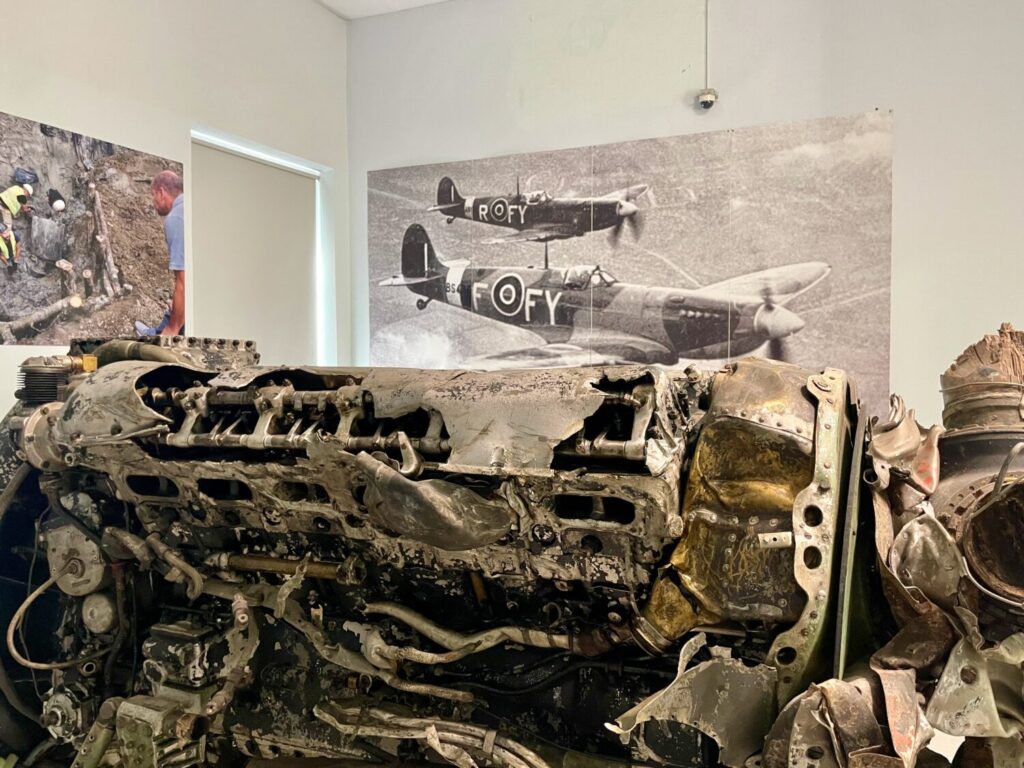
Practical tips for visiting the Park of Military History Pivka
Visiting the Park of Military History Pivka is not just about walking through a museum; it’s an immersive experience that requires a bit of planning. You can choose to stay a couple of hours or spend the whole day, depending on your level of interest.
The park is vast, with several exhibition halls, outdoor areas, gardens, and even a playground for children. It’s also a great option on a rainy day: most of the collections are housed indoors, in the Komanda, A, B, and C pavilions. Only the largest exhibits, such as the locomotive and the patrol boat, are displayed outside.
Inside the Komanda building, which also hosts the ticket office, you’ll find a well-stocked souvenir shop with military vehicle models, books, T-shirts, accessories, and children’s toys, perfect for an original keepsake. The same building also houses the museum’s restaurant, serving simple but tasty dishes and one of the best coffees we’ve had in Slovenia. It’s an excellent stop to recharge during your visit.
Below you’ll find all the practical information about languages, guided tours, tickets, and opening hours to help you make the most of your day at the Park of Military History Pivka.
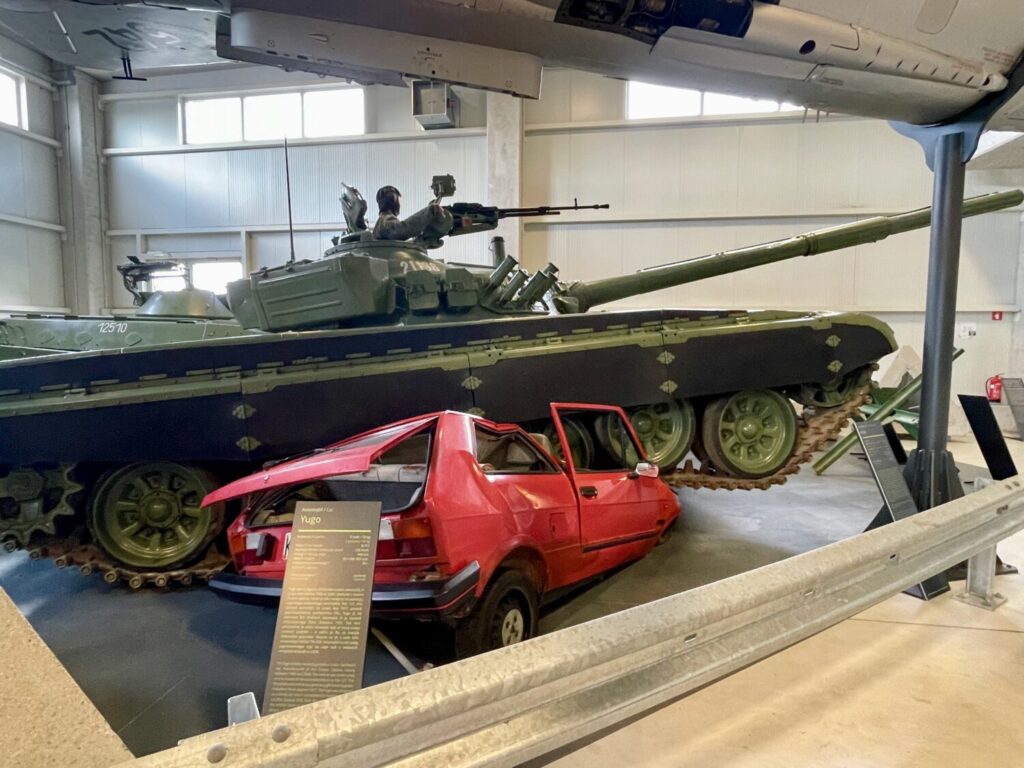
How long does the visit take
On average, visitors spend 2 to 3 hours exploring the permanent and temporary exhibitions, which is usually enough to cover the main highlights. We ended up staying an entire afternoon, and honestly, we would have happily stayed longer if we had managed our time better.
The Park of Military History Pivka is truly vast and full of details you don’t expect. Each pavilion draws you in with something new to discover. That’s why I recommend planning a whole day here. It’s not the kind of museum you rush through, but rather a place to slow down, explore, read, and take it all in at your own pace.
Languages and guided tours
The exhibitions are in Slovene, but all captions are also in English, so it’s easy to follow even if you don’t speak the local language. Guided tours of the submarine and the patrol boat are offered in English and allow you to discover many details and curiosities you might otherwise miss.
Tickets for the Park of Military History Pivka: prices and discounts
Admission to the Park of Military History Pivka costs € 12 for adults, with reduced rates available for students and pensioners. Preschool children pay a symbolic € 0.50, while a family ticket costs € 31, a convenient option if you’re visiting with several children.
On top of the basic ticket, there’s a small surcharge for the submarine and the police patrol boat tours, which you can’t visit independently for safety reasons. In both cases, advance booking is mandatory, especially at weekends and during the summer months.
The museum also offers guided tours of the entire complex, a great choice if you want to explore every section with the help of an expert guide. Due to time reasons we only booked the submarine tour, and it turned out to be a truly unique experience, well worth the extra cost.
Opening hours of the Park of Military History Pivka
The Park of Military History Pivka is open all year round, with schedules that vary by season. In summer, during July and August, the museum is open daily from 9:00 am to 6:00 pm, giving you plenty of time to explore both the indoor pavilions and the outdoor exhibits.
During winter (December to February), opening hours are reduced: Monday to Friday from 11:00 am to 2:00 pm, and until 4:00 pm at weekends. In the other months, the museum generally closes at 4:00 pm, with slightly longer hours in spring and autumn.
For the most up-to-date information, I recommend checking the museum’s official website before planning your visit.
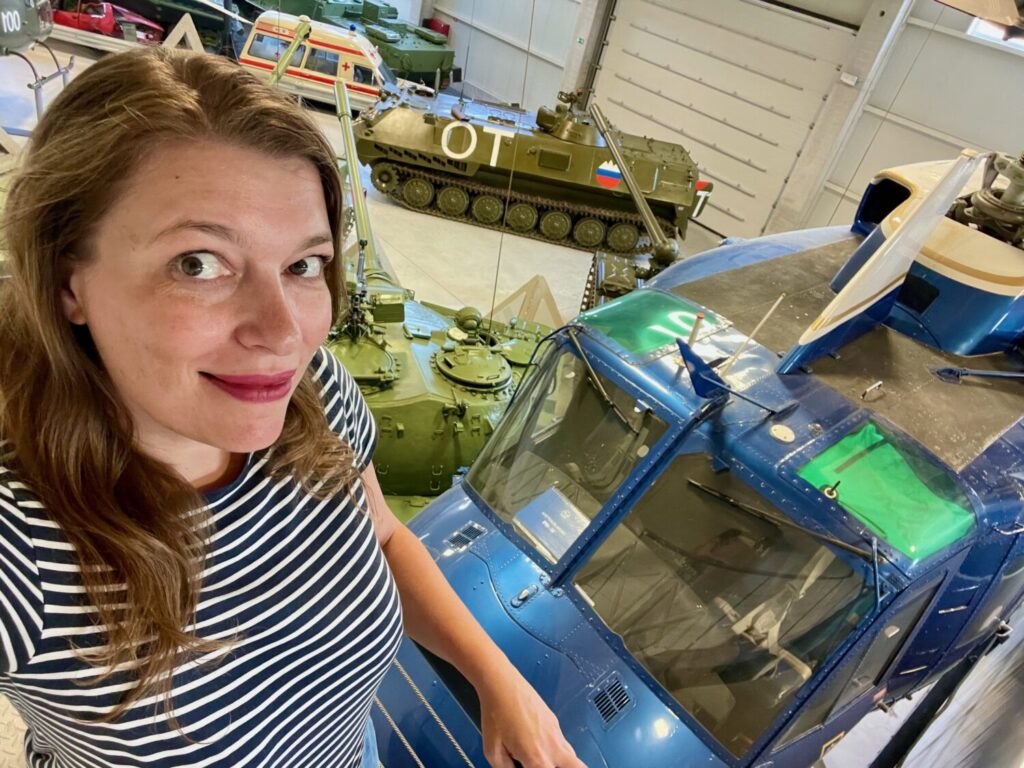
How to get to the Park of Military History Pivka
The museum sits in a mountainous area of Slovenia, so the most convenient way to get there is by car. From Ljubljana, it takes about 1.5 hours, while from Trieste, it is just over an hour. Keep in mind that Slovenian traffic can be heavy. We arrived nearly two hours late due to motorway queues and accidents!
There are also buses stopping nearby, but the last stretch must be done on foot, which I wouldn’t recommend if it’s raining or if you’re travelling with children. The last part of the road itself isn’t too busy, but it’s uphill. Right in front of and inside the museum, you’ll find a free car park, with space also available for campervans.
Park Vojaške Zgodovine Pivka
Park of Military History Pivka
Kolodvorska cesta 51, 6257 Pivka, Slovenia
Visiting the Park of Military History Pivka was a truly memorable experience for me and my son. We were fascinated by the tanks and the Enigma machine, and we deepened our understanding of a chapter of history we only partly knew.
Let me know in the comments if you’ll add the Park of Military History Pivka to the stops on your next trip to Slovenia.
